

The following article may be used free of charge with no prior authorization provided that it is used for nonprofit purposes and appears with the author biography at the end of this article intact. Please email us with any details of its use so that we can keep the author or other interested parties informed of the use of this article.
Splitting Gun
Carlton Lewis
Through the 1930s, timbering was a year-round activity. The first stage, gathering the wood for the coming year, started after the haying was completed. Generally we brought out the misfits first—dead, hollow, stunted, or crooked trees that would be good for firewood (e.g., wood with strong grains like oak, ash, hickory, cherry, elm, maple). After the misfits, we would then harvest the largest mature trees we could find that were in areas where smaller hardwoods were starved for sunlight.
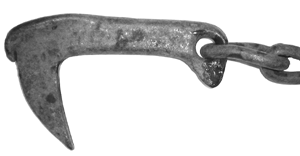 | A grab was a 4" to 6" barb on the end of a chain, used to protect the chain from excessive wear. It would be driven into a heavy log, and the small anvil on the chain end would form a pincer with the barb locking the grab in place. Courtesy of Carlton Lewis, photo by Gerry Stoner. |
Harvesting required axes and two-man saws to cut trees and trim branches, resulting in huge lengths of wood and smaller branches and tops. We would then cut the trunk to lengths that a single horse could drag to the homestead. Generally, these were 8 to 12 feet long and up to 36" in diameter. To drag them out, we would use a chain and grab to attach the logs to a horse's harness.
Throughout the year, the wood would be cut and split for use as firewood, fence posts, and timber, and harvesting would continue periodically as the initial supply of wood was processed.
In the 1930s, power saws were in stationary beds driven by water or gas engines and the wood had to be fed to the blade—there were no portable saws (like chain saws) that could easily cut wood to correct lengths. If you wanted firewood, you would have to get it from 8' to 12' logs with diameters of from 16" to 36"! Given this situation, how would you proceed? Would you split these logs first using wedges and a maul, knowing that you could manhandle the 8' to 12' long pieces of thinner wood onto the small gas-engine-powered saw to cut them into firewood lengths? Or would you use the 2-man saw to get fireplace lengths that you could then split with axes?
The splitting gun provided another option.
 |
This splitting gun (above) is a piece of steel 1 1/2" in diameter, 16" long, and somewhat tapered at one end. It has a 3/4" hole drilled about 9" deep into the center of the shaft and a small hole drilled from the outside of the gun to the bottom of the 3/4" hole. |
To use the splitting gun, you need fuses, a pewter funnel and spoon, and a jar of black powder. Fill the large hole with an appropriate amount of black gunpowder using the pewter funnel and spoon—an appropriate amount being learned by experience. Stop the hole with a piece of wadded paper, position the gun at the end of a length of potential firewood with the small hole pointing up. Drive the splitting gun into the log, and continue setting it into the wood with a maul to a depth of about 3 to 4". Using a piece of straw or pick, clear the touch hole and place a wick into it. Make sure to use pewter, wood, or plastic implements to avoid sparks! The splitting gun is a dangerous weapon—use traditional black powder, NOT modern high-power gunpowder, and do not try to make one. It is truly a historical artifact.
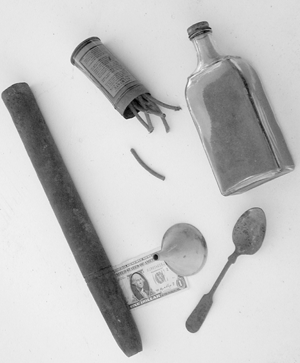 | The splitting gun, fuses, funnel and spoon, and a jar of black powder with the dollar bill shown for size. Courtesy of Carlton Lewis, photo by Gerry Stoner. |
Once the splitting gun is set firmly into the log, take another large piece of wood or rock, and wedge it securely against the butt end of the gun. This will absorb the kick from the firing of the splitting gun. Finally, light the fuse and move well away from the wood. If all goes well, the length of potential firewood will be split into 2 or more strips that can either be further split or are light enough to be jockeyed into position for sawing.
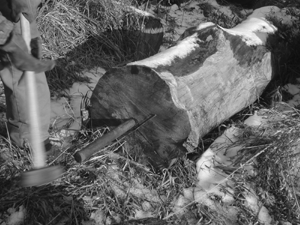 | 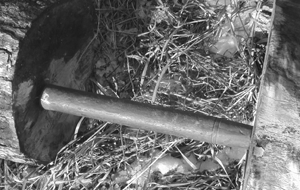 |
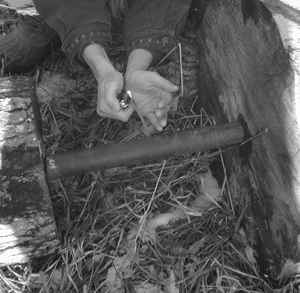 | 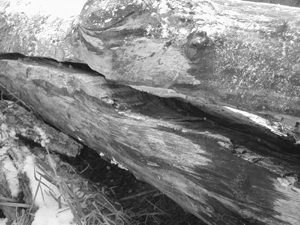 |
| We started with a trimmed log 15 feet in length and with an 18" diameter. As you can see in the top left picture, numerous limbs had been lopped off, leaving burls (knots) within the body of the tree which would be difficult to split and how the loaded splitting gun is driven into the end of the log. Once it has been driven in about 6 inches, a smaller block of wood is set up against the end of the gun (top right). In the bottom left picture, my neighbor, Joy Forbis, lights the fuse, while the bottom right picture shows the split running down the length of the log. With the development of large yet portable chain saws, I use the splitting gun less but still use it when dealing with a log greater than two foot in diameter. Courtesy of Carlton Lewis, photo by Gerry Stoner |
 Carlton Lewis, a dairyman for nearly 30 years, became a master machinist in the early 1970s. At that time, the dairy industry in the Catskills had fallen on hard times, all creameries were cutting back, and the closing of Blenheim Creamery spelled the end for the 500 dairy farms that it served.
Carlton Lewis, a dairyman for nearly 30 years, became a master machinist in the early 1970s. At that time, the dairy industry in the Catskills had fallen on hard times, all creameries were cutting back, and the closing of Blenheim Creamery spelled the end for the 500 dairy farms that it served.
.pdf file audio file
To use this article in your newsletter or as a handout, click into the article; select all; copy; and paste into a MSWord file.
Please remember to let us know of this use so that we can let the author or other interested parties know.
To subscribe or unsubscribe to this site, click here and select northerncatskillhistory (top left link).
Fill in your email address, name (optional), and a simple password.
You will receive an email confirming your intent
Respond to it to subscribe or unsubscribe to northerncatskillhistory.com
November 13, 2010
Copyright © 2009
northerncatskillshistory.com
contact northerncatskillshistory.com
![]()